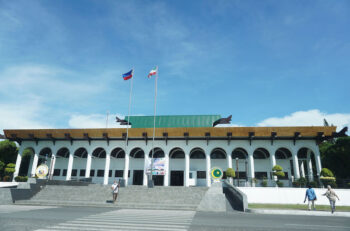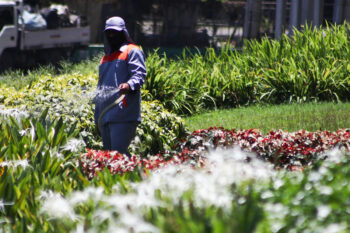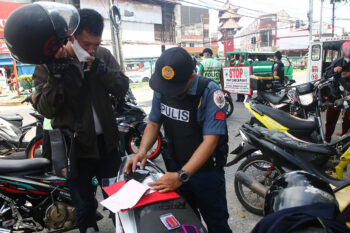DAVAO CITY (MindaNews/15 June) — I crossed the new Bankerohan Bridge today. They opened it for traffic just in time for the first day of school this year. And it was a pleasant surprise. I did not expect the Department of Public Works to finish building the bridge that fast. After all, it did take them quite a while to even dismantle the old one that finally gave up its ghost more than a year ago.
The new bridge is wider, smoother and of course a lot cleaner than the old one, with gleaming new lamp posts standing like honor guards on one side with their swords stretched out in salute. I think they carry the new sodium lamps, the kind that are more energy efficient and emit an eerie orange glow that somehow manages to color even the clouds up there in the night sky.
I felt a twinge of pain as we rode through the bridge, zooming along with the other vehicles, intent on getting to the other side. The bridge’s sides were closed, and from the car, one could no longer see the river; and hadn’t I known that I was crossing a bridge, it would have felt like I was driving through just another part of the highway.
Time was when Bankerohan Bridge was the only bridge in Davao City. You might say that the old bridge and I were practically born together. I remember as a baby that often, to help me get over a tantrum, my father would bundle me into a big black 8-cylinder Ford sedan and drive over to the new bridge, for nothing else but to blink at the bright lights from big glass spheres that housed huge incandescent
bulbs sitting on the extended arms of ornate lamp posts that stood as sentinels along the sides of the bridge.
There weren’t too many cars at that time, and people actually walked across the bridge, often not just to get to the other side, because there wasn’t really much yet on the south side of the bridge; but for the sheer pleasure of walking across, savoring the lights (there weren’t any neon signs then) and pausing in the middle to gaze down at the dark river current that swirled around the concrete pylons of the bridge.
There is something that stirs romance in a bridge that is built not only for people to get across but for the crossing itself. And Bankerohan Bridge was such a bridge. Then.
As a high school student in Ateneo, I used to stay later than I should have in the Matina campus so I could slowly walk down the bridge on my way home, passing my hand over her concrete balustrades, pausing now and then and gazing at the workmen below in the river water who gathered sand in huge tin basins and dumped them on flat bottomed boats to be collected later by trucks along the banks for eventual use in city constructions.
I envied the little boys who swam along the banks and gazed in awe at the braver and more intrepid ones who climbed on the bridge and jumped with whoops of joy and bravado into the current below.
She wasn’t really a beautiful or extraordinary bridge, our Bankerohan Bridge. She spanned that part of the river between what was the only market in the city and what was then considered the boondocks on the other side. She wasn’t anything grand like the Golden Gate Bridge or romantic like the Pont Neuf or historical like the Ponte Vecchio or popular like the London Bridge. But heck, she was OUR bridge, the only one Davao had, and we were mighty proud of her. She was the bridge of my generation. She was our bridge when war erupted between the fans of Elvis Presley and Pat Boone. Later, she took us to jam sessions in the uppity Matina district when the Twist and the Mash Potatoes replaced the Boogie. She heard the first notes of the Beatles’ ‘I want to hold your hand’ over our car radios. And she was silent witness to our adolescent desires, ambitions and heartaches and also to the frequent hormonal rages of our teens.
But people grow up, and eventually go to Manila to study. And a city gets bigger even if bridges do not. So bridges get left behind and lose their romance, just like Puff the magic dragon, his green scales.
Vandals shot away the big glass spheres from the ornate lampposts that were eventually replaced with more utilitarian, if uglier and taller, steel ones. Neon lights and gaudy billboards sprang up like mushrooms overnight in the city and around the bridge. Cars and other vehicles multiplied and people seldom saw the need or had the time to walk leisurely over to the other side. Traffic piled up and soon, the old Bankerohan Bridge (nobody ever called her Generoso Bridge during my time!) was deemed inadequate for the city’s needs. So they built an ugly one beside her, just a shade higher than the old one, as if to show how antiquated and insignificant she had become.
Soon, three more spans were built across the Davao River at more strategic areas and the old Bankerohan Bridge, already suffering from comparison with the new one next to it, lost her previous prominence and became just another convenience. She got lost in the hustle and bustle of a big and strange new city that had no time for genteel late afternoon walks and pensive river gazing.
When I got home from my studies in Manila and abroad, she had practically faded out of sight.
Until April 12, 2007 when she finally decided to die.
Nobody would have noticed the old lady go away, if there had not been the attendant inconvenience of added traffic to her demise.
I often braved the inch-by-inch traffic over the other bridge just to pause a bit and gaze wistfully at the bridge of my childhood as people with jack hammers slowly dismantled her, baring her innards, the steel girders and concrete pylons that sank into the water. I felt sad, watching the autopsy of an old and very dear friend.
I silently begged the engineers and the workers to reverently put her back the way she was before all the other bridges were built. I wanted them to restore her to her previous splendor and importance, alone, as the repository of the images of the childhood and adolescence of my generation.
It was a vain wish, of course. Another bridge would span the same area. It would probably still be called the Bankerohan Bridge. It would be a technically bigger and better bridge and would last longer than the old one. It would carry more people and more cars from one end to the other.
But it would not carry the memories of my generation. They are gone with the old bridge. Swept silently away by the swirling river waters.
Somewhere.
[Dr. Jose “Ting” M. Tiongco, chief executive officer of the Medical Mission Group Hospitals and Health Services Cooperative- Philippines Federation, writes a column, Child of the Sun, for MindaNews. He is author of two books, “Child of the Sun Returning” (1996) and “Surgeons Do Not Cry” (2008). The second book is available at UP bookstore, National bookstore and MindaNews]







